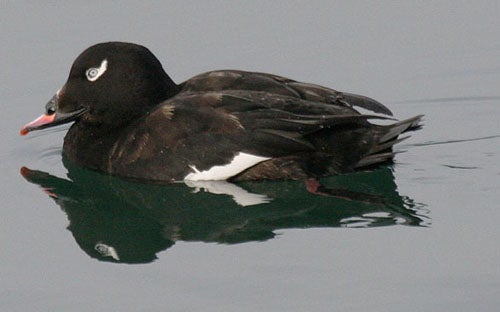SCIENTIFIC NAME:
Melanitta fusca
STATUS:
Rare to occasional in winter, spring, and late fall in all regions. Occasional in summer in Gulf Coast region.
DESCRIPTION:
The white-winged scoter is the largest of three species of scoters that inhabit the oceanic water of North America. They can be identified by their large bill and bulky shape. The white-winged scoters bill is large and has an orange coloration that is accented by a black bump at its base. Males range from 3 to 5 pounds and average 22 inches in length. Coloration is solid black, except for a small ring of white around the eye. Males also exhibit a white speculum which distinguishes them from all other races of scoters. Females are somewhat smaller than males. They average 2.5 pounds and 21 inches in length and are dark brown with a pale brown belly. Juveniles have similar coloration, but exhibit variable amounts of white spots on their head.
DISTRIBUTION:
White-winged scoters winter primarily in large bays and estuaries of northern USA and southern coast of Canada. This species can be located along both the Pacific and Atlantic coastlines of North America during the winter months. On occasion, white-winged scoters have been known to winter in portions of the eastern great lakes. They have become more common since the 1970’s in that region possibly as a direct result of the zebra mussel into the area, which is an abundant food source.
During the spring scoters nest along fresh and brackish lakes in north western Canada and Alaska.
HABITAT:
White-winged scoters utilize inland freshwater habitat during the spring and saltwater coastlines during the winter months. Migration corridors are located along both the Atlantic and Pacific coast. Generally, white-winged scoters are the last species to migrate north. Flocks generally fly low over the sea in long, wavering lines. Staging areas are common and large rafts of the species can be seen along the coast lines of North America. Like other divers, these birds must run across the water surface for a short distance in order to attain flight.
FEEDING HABITS:
The dietary habits of white-winged scoters change from season to season. Wintering areas are primarily associated with saltwater. During this time birds primarily feed on bottom-dwelling mollusk such as clams, mussels and snails. During the breeding and nesting period, prey species are primarily insect larvae and amphiboles.
LIFE HISTORY AND ECOLOGY:
White-winged scoters migrate to the breeding grounds later than most species. Generally speaking, nesting may not occur until mid-June. The nest is nothing more than a shallow depression to which the female adds down. Clutch size varies from five to 12 eggs and incubation lasts for approximately 28 days. Once the eggs are laid, males will migrate to the molting grounds, leaving the females to tend to the brood. Molting will leave these birds flightless for approximately four weeks. Once hatched, several broods may band together. These groups are tended to by several females. This technique may be utilized to minimize predation, however few scoters survive to be adults. Most predation on young occurs by gulls.
Of the 3 species of scoters, the white-winged scoters are thought to have the largest and most abundant population.
REFERENCES:
Bellrose, R.C. 1976. Ducks, Geese and Swans of North America, 2nd. Ed. Stackpole, Pa.
AUTHOR:
Michael E. Sievering, Supervising Wildlife Biologist, Division of Wildlife and Freshwater Fisheries






